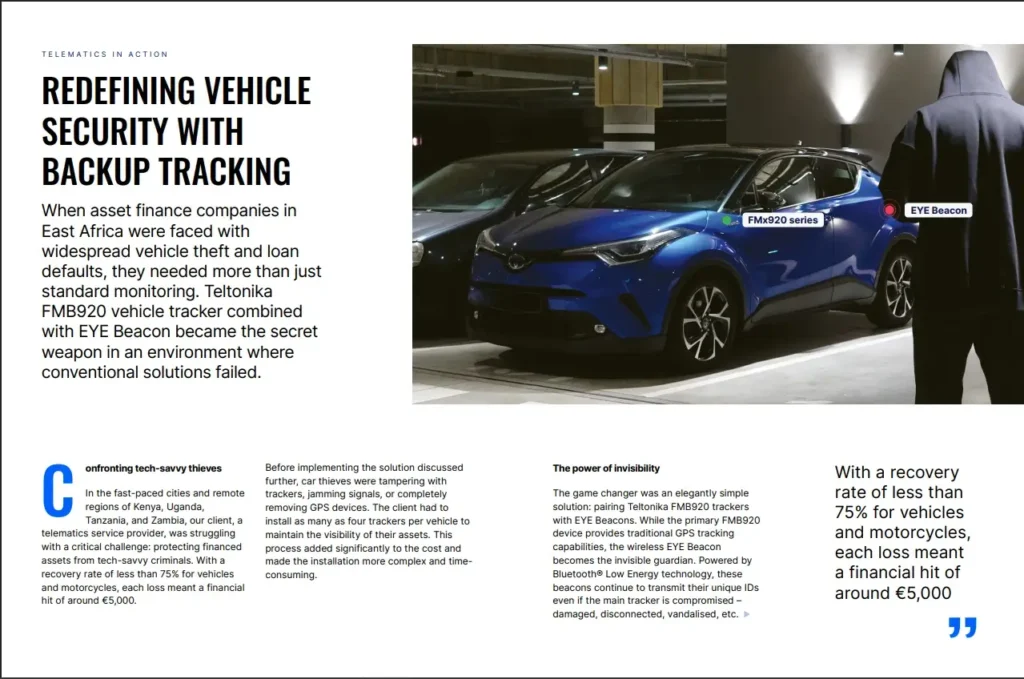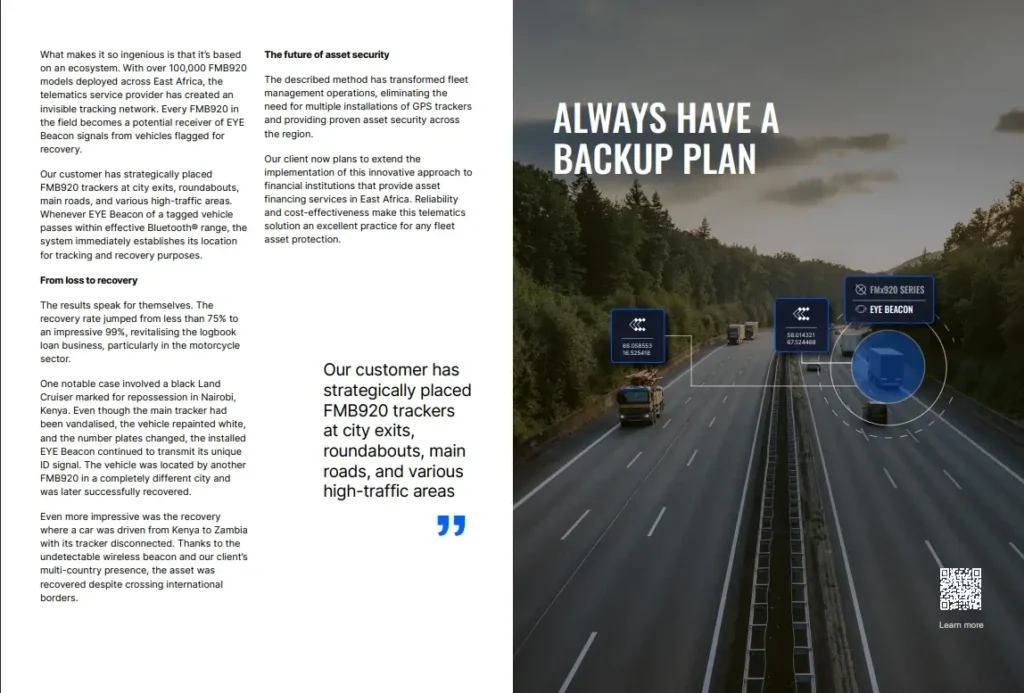In Africa’s quickly growing asset financing and fleet management industries, the risks of vehicle theft, signal jamming, and asset loss are at an all-time high. Traditional GPS tracking alone is no longer enough. Increasingly, forward-thinking telematics providers and financiers are investing in redundant, multi-layered tracking solutions to safeguard their valuable assets.
At WhiteLabel Tracking, we’ve been at the forefront of this evolution, powering one of East Africa’s most successful backup for asset tracking initiatives. A project that saw recovery rates rise from a concerning 75% to a remarkable 99% in high-risk environments by combining primary GPS devices with discreet Bluetooth-enabled EYE Beacons.
In this article, we unpack the lessons from this deployment and why a backup to tracking is no longer a nice-to-have but a strategic necessity.
The Rise of Vehicle Theft Sophistication
Criminal syndicates targeting vehicles, commercial trucks, and motorcycles have adapted fast. Beyond simple theft, they now:
- Jam or disrupt GPS signals
- Locate and disable wired trackers
- Reinstall the tracker on unsuspecting vehicles/motorcycles to throw off recovery/ early warning signs of disconnected trackers.
In markets like Kenya, Uganda, Tanzania, and Zambia, this has led to a situation where even with a GPS tracker installed, assets remain vulnerable. For lenders and fleet operators, each asset loss typically equals a financial hit of $3,000–$10,000, not to mention reputational damage to the respective financiers.
Why Redundancy Matters in Telematics
In technology, redundancy isn’t waste; it’s resilience. In asset tracking, redundancy means having multiple, independent tracking mechanisms operating simultaneously or in backup modes.
But why is this vital?
- If the main GPS tracker is tampered with, removed, or jammed, a discreet secondary beacon continues transmitting.
- Redundant systems reduce the mean time to recovery (MTTR) dramatically.
- They offer asset owners peace of mind, knowing recovery is possible even in dead zones or with sophisticated tampering.
The East Africa Success Story: How It Worked
Initially the customer installed an isolated backup tracker. However, it was bulky, hard to install discreetly, and could only connect once a day for a few minutes in order to last on the internal battery. While this helped with recovery rates, it was costly and did not significantly improve recovery rates.
In collaboration between Teltonika, WhiteLabel Tracking, and a leading regional TSP, our platform was instrumental in developing and deploying a solution using our crowd-sourced network of trackers from all our vendors, and harnessed over 100,000 Teltonika trackers in their operational region to locate any of their backup EYE Beacons. These small Bluetooth beacons with up to 10-year battery life can be easily hidden deep within the vehicle, emit unique identifiers that nearby Teltonika devices (100-meter range) can pick up, even if the primary tracker was removed.
The innovation:
- Teltonika trackers installed in vehicles and strategic hotspots (city exits, border points, major roads) listen for beacon signals.
- If a missing or stolen vehicle equipped with a beacon passes within range, the nearby tracker picks up the signal and reports its location via our backend.
- Real-time alerts enable quick dispatch of recovery teams, even if the original tracker is dead.
The result:
Recovery rates jumped from 75% to 99%. A game-changer for asset financiers, insurers, and fleet managers.
Our multi-country presence has located vehicles where the main tracker has been disconnected in different countries, and even found a high-value Land Cruiser that had been re-sprayed a different colour with different number plates.


What This Means for Fleet & Asset Finance Operators
If your business relies on financed vehicles, logistics assets, or heavy-duty fleets, relying on a single GPS tracker is no longer acceptable.
Key takeaways:
- Adopt a multi-layered asset security strategy
- Incorporate Bluetooth beacon-based backup systems
- Work with partners who support multi-tracking configurations and decentralized signal networks
- Ensure your telematics platform can manage complex signal hierarchies and deliver seamless backup location tracking
The Network Effect: Why Scale Makes It Smarter
One hidden advantage of this system is its decentralized network effect. As more Teltinika trackers and EYE Beacons are deployed, the coverage and detection chances increase exponentially. Every new device you connect isn’t just protecting itself, it also becomes a potential receiver for any nearby stolen asset’s beacon signal. This turns your entire client base into a protective mesh for asset recovery.
At WhiteLabel Tracking, we manage the infrastructure, data routing, and alert logic that powers this dynamic ecosystem.
Looking Ahead: The Future of Backup Tracking
With Africa’s urbanization, cross-border logistics, and vehicle financing markets growing rapidly, backup tracking will soon be standard.
Emerging trends:
- Integration of Iridium satellite modems for no-signal regions
- Predictive theft analytics from beacon signal heatmaps and using a Historical Location Probability Report
- Insurance-linked telematics products offering lower premiums for fleets with redundant tracking solutions
- More cross-border recovery networks via decentralized telematics infrastructure
Conclusion
Redundancy in tracking isn’t about extra cost; it’s about guaranteed control. The East Africa recovery success story proves that well-architected backup tracking systems can save millions in asset losses, improve operational resilience, and win customer trust.
As we lead through continuous innovations, we are ready to help you build smarter, safer, multi-layered asset security strategies. Contact us today and let’s future-proof your fleet.